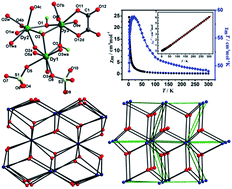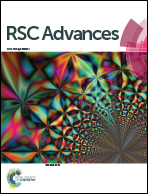Ferromagnetically coupled chiral dysprosium hydroxysulfate and centrosymmetric dysprosium hydroxysulfate-oxalate: Dy4(OH)4 cubane based high-connected networks via in situ conversion of organosulfur to sulfate†
Abstract
Hydrothermal reaction of Dy(NO3)3, 2-amino-5-mercapto-1,3,4-thiadiazole and (NH4)2C2O4 in the presence of triethylamine resulted in two dysprosium hydroxysulfates, namely [Dy4(OH)4(SO4)4(H2O)3] (1) and [Dy4(OH)4(SO4)3(ox)(H2O)6] (2) (ox = oxalate), in which the sulfates came from in situ oxidized conversion of the organosulfur of 2-amino-5-mercapto-1,3,4-thiadiazole. Both 1 and 2 are constructed from cubane-like Dy4O4 clusters, which extend via sulfate and oxalate into 3D highly-connected networks. Compound 1 crystallizes in the orthorhombic chiral space group P212121 and has 3D (12,3)-connected Au4Ho-like topology in which Dy4(μ3-OH)4 cubane clusters serve as twelve-connected nodes and sulfates serve as three-connected nodes, while compound 2 crystallizes in the orthorhombic centrosymmetric space group Pbcm and shows a 3D (10,3)-connected unprecedented network with coordinated oxalates in which Dy4(μ3-OH)4 cubane clusters act as ten-connected nodes and sulfates act as three-connected nodes. Detailed comparison of experimental parameters indicated that the amount of lanthanide ions played a significant role in tuning the nuclearity of metal clusters and the local connectivity number of specific networks. Differing from antiferromagnetic coupling observed in known Dy4(μ3-OH)4 cubane-like compounds, 1 and 2 exhibit unusual ferromagnetic coupling.


 Please wait while we load your content...
Please wait while we load your content...